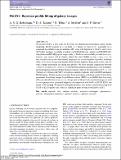Files in this item
ProFit : Bayesian profile fitting of galaxy images
Item metadata
| dc.contributor.author | Robotham, A. S. G. | |
| dc.contributor.author | Taranu, D. S. | |
| dc.contributor.author | Tobar, R. | |
| dc.contributor.author | Moffett, A. | |
| dc.contributor.author | Driver, S. P. | |
| dc.date.accessioned | 2018-01-22T15:30:34Z | |
| dc.date.available | 2018-01-22T15:30:34Z | |
| dc.date.issued | 2017-04 | |
| dc.identifier | 252098030 | |
| dc.identifier | 75b7e8fa-12cc-4463-a5c8-7896b1ed7a7d | |
| dc.identifier | 85037619720 | |
| dc.identifier.citation | Robotham , A S G , Taranu , D S , Tobar , R , Moffett , A & Driver , S P 2017 , ' ProFit : Bayesian profile fitting of galaxy images ' , Monthly Notices of the Royal Astronomical Society , vol. 466 , no. 2 , pp. 1513-1541 . https://doi.org/10.1093/mnras/stw3039 | en |
| dc.identifier.issn | 0035-8711 | |
| dc.identifier.other | ArXiv: http://arxiv.org/abs/1611.08586v2 | |
| dc.identifier.uri | https://hdl.handle.net/10023/12574 | |
| dc.description.abstract | We present ProFit, a new code for Bayesian two-dimensional photometric galaxy profile modelling. ProFit consists of a low-level c++ library (libprofit), accessible via a command-line interface and documented API, along with high-level R (ProFit) and Python (PyProFit) interfaces (available at github.com/ICRAR/libprofit, github.com/ICRAR/ProFit, and github.com/ICRAR/pyprofit, respectively). R ProFit is also available pre-built from cran; however, this version will be slightly behind the latest GitHub version. libprofit offers fast and accurate two-dimensional integration for a useful number of profiles, including Sérsic, Core-Sérsic, broken-exponential, Ferrer, Moffat, empirical King, point-source, and sky, with a simple mechanism for adding new profiles. We show detailed comparisons between libprofit and galfit. libprofit is both faster and more accurate than galfit at integrating the ubiquitous Sérsic profile for the most common values of the Sérsic index n (0.5 < n < 8). The high-level fitting code ProFit is tested on a sample of galaxies with both SDSS and deeper KiDS imaging. We find good agreement in the fit parameters, with larger scatter in best-fitting parameters from fitting images from different sources (SDSS versus KiDS) than from using different codes (ProFit versus galfit). A large suite of Monte Carlo-simulated images are used to assess prospects for automated bulge-disc decomposition with ProFit on SDSS, KiDS, and future LSST imaging. We find that the biggest increases in fit quality come from moving from SDSS- to KiDS-quality data, with less significant gains moving from KiDS to LSST. | |
| dc.format.extent | 10978202 | |
| dc.language.iso | eng | |
| dc.relation.ispartof | Monthly Notices of the Royal Astronomical Society | en |
| dc.subject | Methods: data analysis | en |
| dc.subject | Methods: statistical | en |
| dc.subject | Techniques: photometric | en |
| dc.subject | Galaxies: fundamental parameters | en |
| dc.subject | Galaxiess: statistics | en |
| dc.subject | Galaxies: structure | en |
| dc.subject | QB Astronomy | en |
| dc.subject | QC Physics | en |
| dc.subject | DAS | en |
| dc.subject.lcc | QB | en |
| dc.subject.lcc | QC | en |
| dc.title | ProFit : Bayesian profile fitting of galaxy images | en |
| dc.type | Journal article | en |
| dc.contributor.institution | University of St Andrews. School of Physics and Astronomy | en |
| dc.identifier.doi | https://doi.org/10.1093/mnras/stw3039 | |
| dc.description.status | Peer reviewed | en |
| dc.identifier.url | http://arxiv.org/abs/1611.08586v2 | en |
This item appears in the following Collection(s)
Items in the St Andrews Research Repository are protected by copyright, with all rights reserved, unless otherwise indicated.

